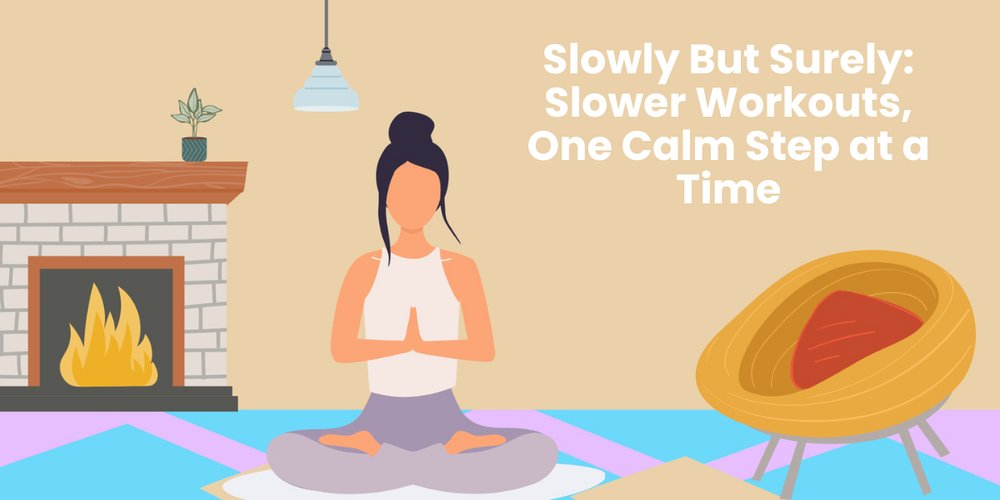Slowly But Surely: Slower Workouts, One Calm Step at a Time

Stay tuned to our latest news
“Embrace Your Pace” is more than just a phrase; it is a philosophy for individuals who march to the beat of their own drum. As the seasons transition from the fresh blossoms of April to the sunlit days of June, this ongoing RENPHO series will help to highlight the myriad ways one can embrace a life lived at their own pace.
In recent years, there has been a gradual shift in the fitness world towards slower, more intentional workouts. This growing trend is gaining popularity among individuals seeking a balanced approach to their fitness routines. While many people still believe that faster and harder workouts are always better, the concept of slower workouts challenges this misconception.
The fast-paced, high intensity exercise regimens that were once hailed as the most effective way to achieve fitness goals are now being questioned. Slower workouts prioritize mindful movement and deliberate control over excessive speed and intensity. They encourage individuals to tune in to their bodies, focusing on proper form and technique rather than pushing for maximum speed or weight.
One of the major advantages of slower workouts is its ability to reduce the risk of injury. By taking the time to properly warm up, stretch, and engage in controlled movements, individuals can avoid strains and overexertion. Slower workouts also allow for better muscular engagement, as the focus shifts from simply completing the exercise to performing it with precision and awareness.
Furthermore, slower workouts provide an opportunity for mental relaxation and stress relief. They allow individuals to disconnect from the demands of a fast-paced lifestyle and truly focus on the present moment. This holistic approach to fitness promotes an overall sense of well-being and encourages individuals to cultivate a deeper mind-body connection.
The Science of Slow

The science behind slower-paced workouts revolves around the concept of engaging different energy systems within our body. While high-intensity workouts have gained popularity in recent years, there is a growing body of evidence supporting the physiological benefits of slower-paced exercises.
Firstly, slower workouts can have a positive impact on cardiovascular health. When engaging in lower intensity exercises such as jogging or swimming at a moderate pace, our heart rate increases gradually. This sustained increase in heart rate strengthens our cardiovascular system over time, enhancing its ability to pump oxygenated blood to our muscles more efficiently. As a result, our overall heart health improves, reducing the risk of cardiovascular diseases.
Secondly, slower-paced workouts can lead to improved muscle strength. During these exercises, our muscles are under constant tension for an extended period of time. This sustained tension activates slow-twitch muscle fibers, which are responsible for long-lasting muscular contractions. By targeting these fibers, slower workouts can develop muscular endurance, leading to increased strength over time.
Lastly, slower-paced workouts enhance our endurance levels. By exercising at a lower intensity, our body taps into the aerobic energy system, which relies on fat as a primary source of fuel. As we gradually increase our aerobic capacity through these workouts, our body becomes more efficient at utilizing fat for energy. This can improve our endurance levels, allowing us to perform physical activities for longer durations without experiencing fatigue.
Mental Health Benefits

Taking workouts at a slower pace can have numerous mental and emotional advantages. Reduced stress is one of the key benefits. Physical activity, even at a slower pace, helps to lower the production of stress hormones like cortisol and adrenaline, and stimulates the release of endorphins, which are known as the body's natural mood boosters. This can significantly improve one's mental well-being and provide a sense of calm.
Moreover, working out at a slower pace allows individuals to focus more on their movements and body awareness, thus increasing mindfulness. By slowing down and tuning into their body, people can better connect with their physical sensations and emotions. This increased mindfulness during exercise can lead to better overall mental health, as individuals become more attuned to their thoughts and feelings, and can better manage stressors and difficulties they may face.
Listening to Your Body

Listening to your body during exercise is crucial for your overall health and well-being. It is important to tune in and pay attention to the signals your body is sending you, as these signals can help you avoid injury and ensure that you are working out in a way that is beneficial and safe for you.
One way to listen to your body is by being aware of how you feel during your workout. Are you feeling fatigued or energized? Are you experiencing any pain or discomfort? By recognizing these sensations, you can adjust your intensity or modify your exercises accordingly.
It is also important to respect your body's limits. Pushing yourself too hard can lead to overexertion and injury. Instead, try to find a balance between pushing your limits and listening to what your body needs. This means not comparing yourself to others and focusing on what feels right for you.
Another tip is to take breaks when needed. Rest is essential for muscle recovery and preventing burnout. If you are feeling exhausted, take a rest day or engage in a low-impact activity to give your body time to recuperate.
Quality Over Quantity
When it comes to workouts, quality definitely trumps quantity. While it may be tempting to focus on completing a high number of repetitions or finishing a workout as fast as possible, prioritizing quality will yield far better results in terms of effectiveness and overall fitness gains.
The importance of workout quality lies in the fact that it ensures each movement is performed correctly, minimizing the risk of injury and maximizing muscle engagement. By slowing down the pace and focusing on perfecting technique, individuals can enhance muscle activation and recruit more muscle fibers. This not only increases the effectiveness of the exercise but also leads to more significant strength and muscle gains over time.
Slower workout techniques, such as tempo training, are excellent examples of how quality can be optimized. Tempo training involves controlling the speed of each repetition, emphasizing different phases of the movement. For example, performing a slower eccentric (muscle-lengthening) phase during a squat can significantly increase muscle activation and lead to better muscle growth. Another technique is isometric training, where muscles are held in a contracted position for a specific duration. This allows for maximal muscle recruitment and can lead to significant strength gains.
Integrating Slower Workouts into Your Routine

Incorporating slower workouts into a busy lifestyle can seem like a challenge, but with a bit of planning and dedication, it is definitely possible. Here are some practical tips to help you integrate slower workouts into your routine:
-
Prioritize and schedule: Assess your daily schedule and identify pockets of time that can be dedicated to slower workouts. This could be early mornings, during lunch breaks, or in the evenings. Block out these slots on your calendar, treating them as non-negotiable appointments.
-
Start small: Begin by committing to shorter, slower workouts, such as 10-15 minutes a day. This way, it will be easier to fit them into your busy schedule and gradually build up your routine.
-
Be flexible: If you find it difficult to spare dedicated workout time, try incorporating slow exercises throughout your day. Take short breaks to stretch, do deep breathing exercises, or practice mindfulness during tasks like walking, standing, or sitting.
-
Explore different types of slower workouts: Yoga, Pilates, and tai chi are excellent options for incorporating slower workouts. They offer a variety of movements that improve strength, flexibility, balance, and mindfulness.
-
Make it a habit: Consistency is key, so make a commitment to yourself and stick to it. Consider finding a workout buddy or joining a class to stay motivated and accountable.
Remember, slower workouts can provide immense physical and mental benefits, helping you maintain balance and de-stress amidst a busy lifestyle. By prioritizing and planning, you can successfully integrate them into your routine and reap the rewards.
Renpho Health Tips
-

An Introvert's Manifesto for Thriving at Your Own Rhythm
April 11, 2024
Read more >
-

The Wellness of Waiting: How Delayed Gratification Can Lead to Healthier Choices
April 15, 2024
Read more >
-

The Beauty of a Measured Stride: Balancing Ambition with Well-being
April 18, 2024
Read more >
-

Happy Feet, Healthy Steps: How Regular Massage Can Help Prevent Foot Injuries
April 19, 2024
Read more >
-

RENPHO Chats: Navigating Motherhood and Creativity with TikTok’s CallMeNathalie
April 18, 2024
Read more >







